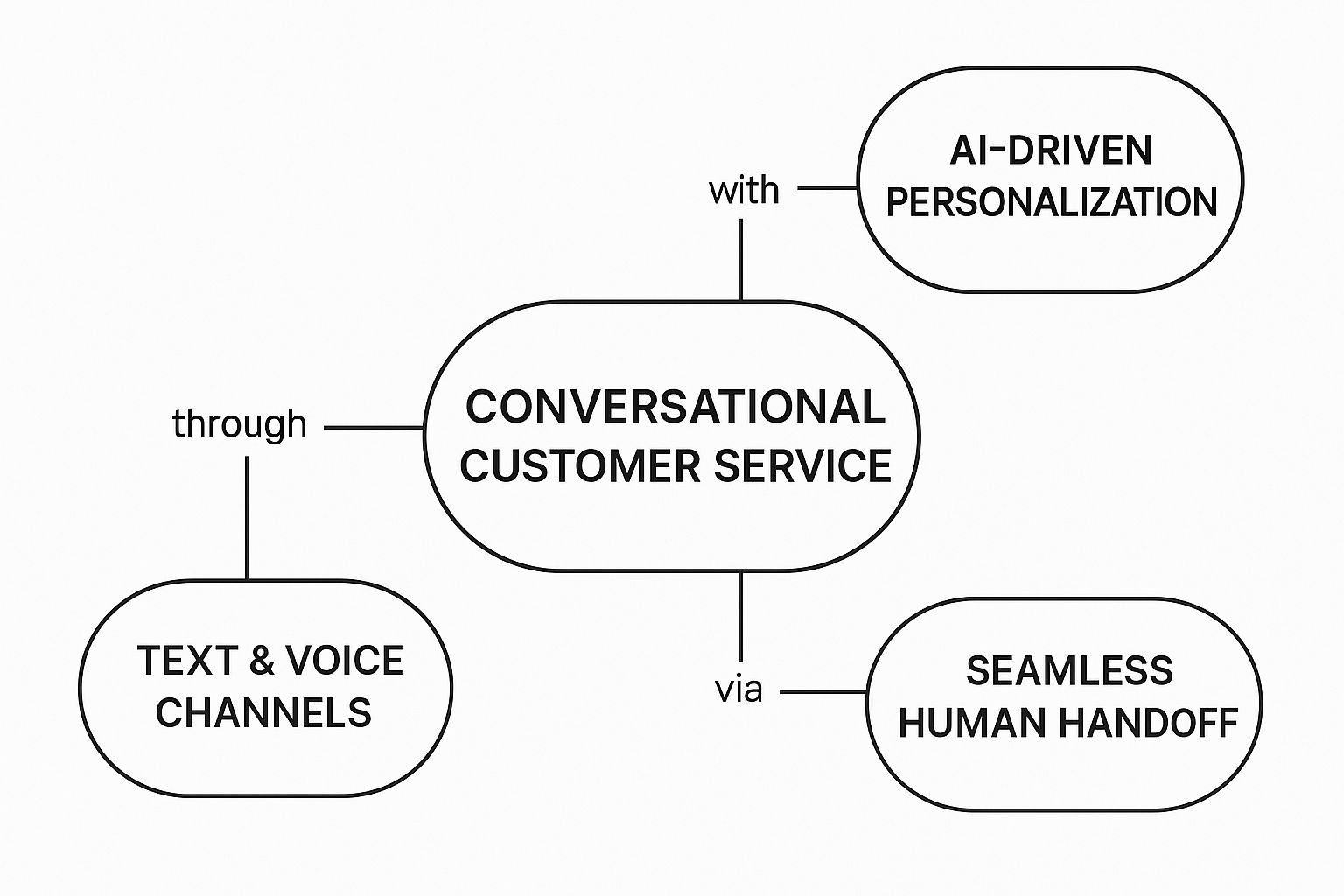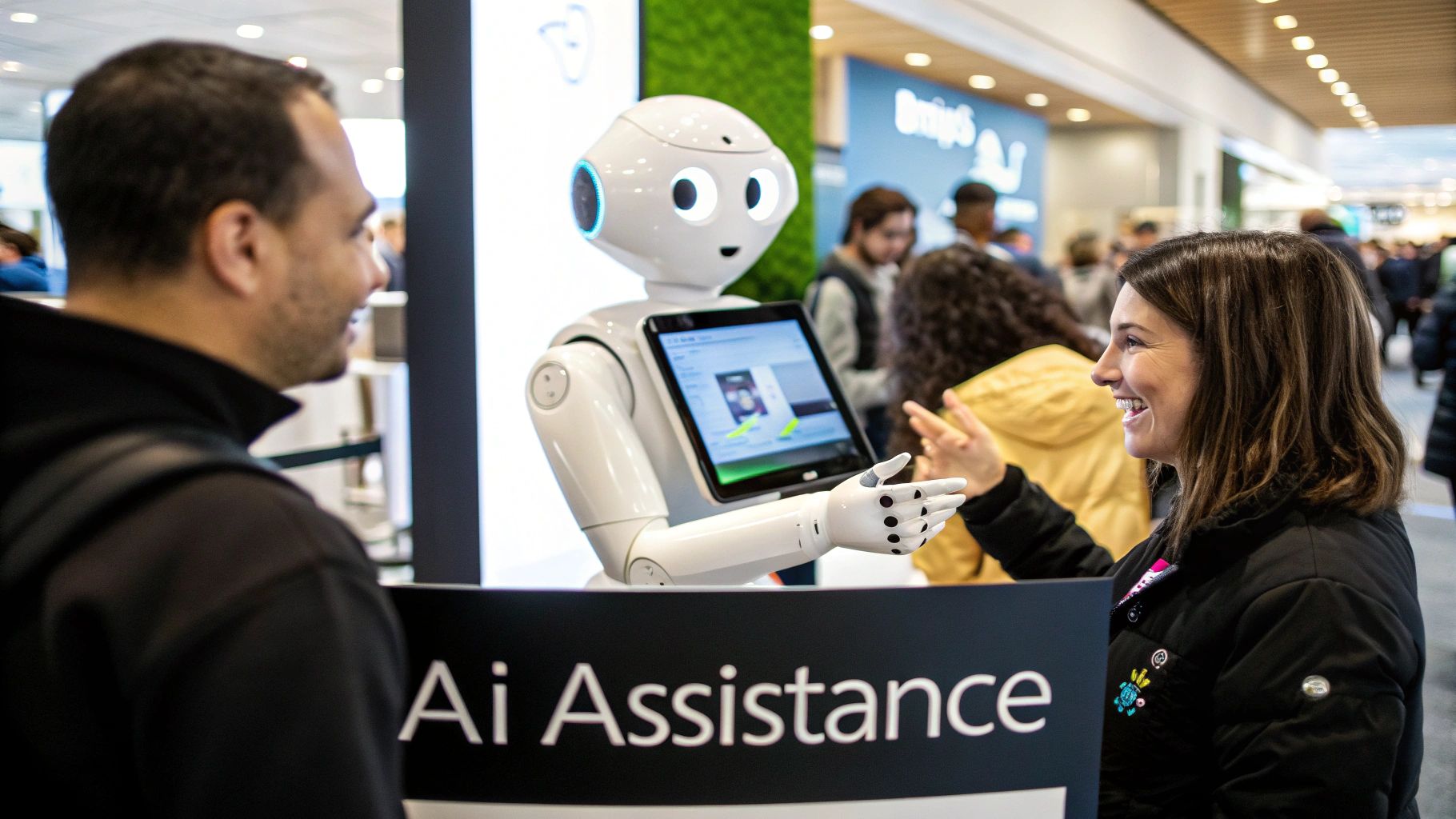Let's be honest, nobody enjoys feeling like just another ticket number. Conversational customer service is all about throwing that old, robotic model out the window. Instead of treating every customer interaction as a separate, one-off problem, it creates a single, ongoing conversation.
Think of it like this: it's the difference between having a running chat with a helpful friend who remembers your past conversations and starting a brand new, formal email chain every single time you have a question. This approach is designed to make every interaction feel natural, personal, and genuinely human.
Imagine sending a stiff, formal email to a generic support inbox. You wait, you get a templated response, and the whole process feels cold and slow. Now, picture texting a small business owner you know. The conversation is quick, informal, and it picks up right where you left off. That's the feeling conversational customer service aims to replicate for every customer.
It's a big shift from the reactive, ticket-based systems we've all grown used to. Instead of forcing customers down separate channels where they have to repeat their story over and over, this strategy weaves everything into one seamless thread. A chat that starts on your website can easily move to a text message or a phone call without the customer ever losing their place or having to start from scratch.
So, what makes this all tick? It boils down to a few key ingredients:
This approach creates a connected ecosystem where all the pieces—from your chatbot to your human team—work together seamlessly.

As you can see, it's not just about the tech. It’s about creating a smart system where technology makes human connections even stronger.
To see the difference clearly, let's break down the old way versus the new way.
This table gives a quick snapshot of how the two models stack up against each other.
The move toward a conversational model isn't just a minor tweak; it's a completely different way of thinking about customer support—one that puts the relationship first.
So, how do you provide this kind of personal, always-on service without hiring a massive team? This is where Artificial Intelligence comes in. AI is the engine that lets conversational service run at scale.
AI tools, like smart chatbots and voice assistants, can instantly handle the flood of routine questions that businesses get every day. This frees up your human team to focus their brainpower on the more complex, nuanced problems where they can really shine.
This "human-in-the-loop" strategy isn't just about being more efficient. It's about combining the speed of automation with the warmth of human empathy to create experiences that build real, lasting loyalty.
And this isn't some far-off future trend; it's happening right now. It's predicted that by 2025, AI will be involved in around 95% of all customer interactions, fundamentally changing what people expect from businesses. This massive shift is what allows a small business to offer the kind of instant, personalized help that was once only possible for giant corporations. To dig deeper, you can learn more about the future of AI in customer interactions and see why it’s becoming the new standard.
In a world overflowing with choices, the customer experience has become the new battleground for businesses. It’s not just about offering support anymore; it's about creating genuine connections. This is where conversational customer service stops being a "nice-to-have" and becomes absolutely critical for survival and growth.

Think about it. Today's customers expect everything now. They want answers right away, not in "one to two business days." Conversational service meets this demand head-on, offering immediate, 24/7 support that doesn't sleep. This instant availability does more than just solve problems quickly—it builds trust and boosts customer satisfaction from the very first interaction.
On top of that, these interactions are deeply personal. Instead of treating every customer like a stranger, conversational systems remember past conversations and preferences. This allows them to offer tailored solutions and recommendations, turning a generic support ticket into a memorable, loyalty-building moment.
The benefits of going conversational aren't just about making customers happy. It directly impacts your bottom line through some serious operational efficiencies.
By automating routine questions—like "Where's my order?" or "Can I book an appointment?"—AI-powered systems free up your human agents. This lets your team focus their energy on complex, high-value problems where a human touch really matters. The result? A more productive team and lower operational costs.
The core idea is simple but powerful: let technology handle the repetitive tasks so your team can focus on building meaningful relationships. This strategy enhances both efficiency and empathy.
This shift is happening for a reason. The conversational AI market is exploding, projected to hit nearly $14 billion by 2025 with an annual growth rate of about 22%. This rapid growth shows just how much value businesses are finding in these intelligent systems. For more on this trend, check out the insights on Language I/O.
A truly effective conversational strategy makes sure the experience is consistent everywhere. Whether a customer starts a chat on your website, sends a text, or calls your business, their conversation history should follow them. No more making frustrated customers repeat themselves over and over again.
This seamless experience is the foundation of what’s known as omnichannel customer service. It ensures that every touchpoint feels like part of one continuous dialogue, no matter the channel. You can learn more by reading our guide on what is omnichannel customer service and how it creates a unified journey.
Ultimately, adopting conversational service isn't just about modernizing your support—it's about showing fundamental respect for your customer's time and building a brand they’ll actually want to stick with.
A truly great conversational customer service experience doesn't just happen by accident—it’s the result of a deliberate, well-thought-out strategy. Making the leap from separate, siloed support channels to a single, unified model requires a solid foundation built on three core pillars. When these elements work in harmony, you create a system that’s both incredibly efficient and deeply personal.
This isn't just about slapping a chatbot on your website and calling it a day. It’s about completely rethinking how conversations flow across your entire business, ensuring a consistent and context-aware experience at every single touchpoint. The real goal is to make every interaction, whether with an AI or a person, feel like one continuous, helpful dialogue.
The first pillar is creating a true omnichannel presence. In simple terms, this means a customer's conversation history follows them seamlessly, no matter how they choose to reach out. A chat started on your website should be right there for an agent to see if the customer later sends a text or calls your business.
This one simple change eliminates the biggest frustration in traditional support: forcing customers to repeat themselves over and over. An omnichannel approach ensures every interaction builds on the last, creating a single, unified story for each customer. This doesn't just reduce their effort; it builds trust and shows you actually value their time.
The second pillar is all about using AI and automation intelligently. This is where tools like an AI Front Desk become a game-changer. The primary job for AI in your strategy is to handle the high-volume, repetitive tasks that eat up your team's time, and to do it instantly, 24/7. This includes things like:
By automating these routine queries, you free up your human team to focus on what they do best. To see this in action, you can explore how AI receptionists are enhancing the customer experience with superior, on-demand service.
A well-implemented AI doesn't replace your team; it empowers them. It acts as a tireless first line of support, filtering and resolving common issues so human agents can apply their expertise to more complex, high-value conversations.
This intelligent automation guarantees that simple problems get solved on the spot, while trickier issues are perfectly teed up for a human agent to handle.
The final, and arguably most crucial, pillar is perfecting the collaboration between your AI and your human team. A successful conversational strategy lives or dies by a seamless handoff process. When a customer's question gets too complex or emotionally charged for the AI, the system needs to escalate it to a person without any friction.
And this isn't just a blind transfer. The AI must pass along the entire conversation history, with all the relevant context, so the human agent can jump in without missing a beat. The customer should never, ever have to start over. This synergy ensures that efficiency and empathy work hand-in-hand, creating a powerful customer service engine that drives loyalty and satisfaction.
Okay, so you have a strategy. Now what? Moving from a plan on paper to a real, working system can feel like a huge leap. But it doesn't have to be.
The trick is to break it down. Start small. Focus on the quick wins—the tasks where automation can immediately make life easier for both your customers and your team. This way, you build momentum right from the get-go.
Think of a platform like AI Front Desk as your central hub. The first order of business is to map out the most common, repetitive conversations your team handles day in and day out. These are the perfect candidates for automation because they offer the fastest return on your investment by freeing up your people.
Before you even think about designing a conversation, you need to know what problem you're solving. What are the top three to five questions your team is tired of answering? Seriously, ask them. Pinpointing these high-frequency tasks is the first, most crucial step.
Here are a few classic examples:
By tackling these areas first, you immediately lighten the load on your staff and give customers the instant answers they’ve come to expect.
The goal isn't to automate everything at once. It's to strategically automate the right things—the tasks that consume the most time and have the biggest impact on customer satisfaction.
Once you know your core use cases, the next move is picking your channels. Go where your customers are. Whether they prefer calling, texting, or using your website chat, a smart conversational strategy meets them right where they're at.
With your use cases and channels locked in, it's time for the fun part: designing the actual conversations. The aim here is to create interactions that feel natural and genuinely helpful, not like talking to a robot from the 90s. Map out a logical flow for each conversation, thinking ahead to what a customer might ask and guiding them smoothly to a solution.
The real magic of a tool like AI Front Desk is how it connects with the systems you already use.

This backend integration is what separates a good experience from a great one. It allows the AI to pull real-time information and actually do things for the customer, creating a truly seamless interaction.
This kind of automation is completely changing the game for contact centers. In fact, projections show that by 2026, conversational AI is expected to slash contact center labor costs by a staggering $80 billion worldwide. Voicebots and chatbots are on track to automate roughly 10% of all agent interactions.
For any business ready to jump in, exploring professional AI customer support services can give you a serious head start. From the initial setup and training to launch and ongoing tweaks, having a clear roadmap ensures your conversational strategy doesn't just work—it wows.
Once you’ve got your conversational customer service up and running, its success really boils down to the quality of the interactions it creates. Let's be honest, a clunky, poorly designed conversation can be even more frustrating than having no one to talk to at all. To steer clear of the common traps and build experiences that actually delight customers, you need to stick to a few core principles.
Think of these as the golden rules for making your automated chats feel helpful, human, and perfectly in sync with your brand. It’s how you turn a simple question into a chance to build real loyalty. They’re all about clarity, consistency, and creating a smooth bridge between your AI and your human team.
Your AI is basically a new team member—and a very public-facing one at that. Its personality needs to match the tone you’ve already set everywhere else. Whether you’re professional and formal or friendly and casual, an inconsistent voice can be jarring and feel completely off-brand.
When you nail the brand voice, every touchpoint, whether it's automated or human, feels like it’s coming from the same company.
The goal is for customers to feel like they are interacting with your business, not just an AI. This subtle but crucial distinction is what separates a helpful tool from a frustrating obstacle.
Transparency is your best friend when a customer starts chatting with an AI. It’s smart to be upfront that they’re talking to a virtual assistant while also clearly outlining what it can and can’t do.
Just as important is designing a seamless, totally frictionless handoff to a human agent when the AI hits its limit. Nothing kills an experience faster than a customer getting stuck in an endless AI loop, repeating the same thing over and over. Your system absolutely must recognize when to escalate a complex or emotional issue to a person, transferring the full conversation history so the customer never has to repeat themselves.
The best conversations feel personal. Use the data you have—like a customer’s name or their past interactions—to make the dialogue feel less generic. A simple "Welcome back, Sarah!" goes a surprisingly long way.
And while AI doesn't have feelings, it can be programmed to recognize them and respond with empathetic language. Training your AI to pick up on frustration or urgency and then adjust its tone is a game-changer for the customer experience. For a deeper dive, you can explore how AI receptionists can be programmed to better understand human emotion.
At the end of the day, top-tier conversational customer service doesn't just spit out answers. It makes people feel heard and valued every step of the way.

We're on the cusp of a major shift in how businesses talk to their customers. The old way was reactive—wait for a problem, then solve it. The future, however, is all about being proactive. Imagine an AI that doesn't just respond to requests but actually anticipates them before the customer even thinks to ask.
This is a fundamental change from simply solving problems to preventing them in the first place.
Think about it: an AI could notice a customer hesitating on your checkout page and pop up with an offer to help. Or it might send a shipping update the second a delay is detected, long before the customer starts wondering where their package is. This kind of foresight elevates a standard service interaction into something genuinely exceptional and loyalty-building.
So, what's powering this proactive future? The short answer is hyper-personalization. AI will increasingly use predictive analytics to understand individual customer behaviors, habits, and needs on a much deeper level. This isn't just about using their first name in an email; it's about delivering true one-to-one interactions, but at a massive scale.
Instead of lumping customers into broad segments, future systems will treat them as individuals with unique histories and preferences, crafting every interaction just for them.
This isn't some far-off sci-fi concept; it's where the entire industry is headed. Getting on board with a conversational customer service strategy now is your first, most important step toward building these next-generation relationships.
If you want a closer look at what's coming, you can explore the future of customer service and see exactly how AI is leading the charge. Adopting this approach today ensures your business is ready for a future where every single conversation is a chance to earn a customer for life.
Got a few questions still kicking around about conversational customer service? Perfect. Let's tackle some of the most common ones we hear from businesses just like yours.
Not anymore. While the big players did help pave the way, today's conversational platforms are built to scale up or down, making them incredibly affordable. This puts them well within reach for small and medium-sized businesses (SMBs) looking to punch above their weight.
Think about it: an SMB can suddenly offer 24/7 support or automate tedious tasks like booking appointments. That frees up a small, scrappy team to focus on the stuff that actually grows the business.
Nope. The real goal here isn't replacement—it's collaboration. AI is fantastic at handling the high-volume, repetitive questions that come in day after day, answering them instantly and without errors.
This smart partnership frees up your human agents to handle the complex, tricky situations where empathy, critical thinking, and a human touch really matter. The best setups create a fluid handoff between the AI and your human experts.
You can track the return on your investment (ROI) by looking at a few key business metrics. You're looking for real, measurable improvements in areas that directly affect your bottom line.
Here’s what to keep an eye on:
Ready to see what conversational service can do for your business? My AI Front Desk gives you a powerful, easy-to-use AI receptionist that converts more leads and boosts revenue, 24/7. Get started today at myaifrontdesk.com.
Start your free trial for My AI Front Desk today, it takes minutes to setup!








